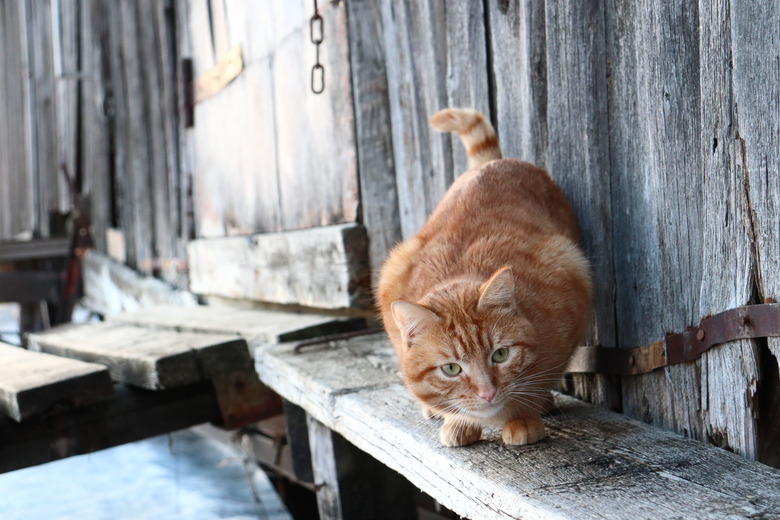Cat Tail Injuries: Symptoms And Treatment
A cat's tail expresses their mood, assists their balance, and distracts prey as they swish it about. It's a vulnerable piece of equipment that always trails them, making it prone to injury, such as getting caught in doors or being stepped on. Tail trauma is fairly common in cats, and occasionally, a cat may develop stud tail, a skin disease at the base of the tail.
Anatomy of a cat's tail
Anatomy of a cat's tail
Your cat's tail contains up to 20 caudal vertebrae surrounded by muscle, and it is able to move in a variety of ways, from small little tips of the tail to sweeping, side-to-side glides. The tail muscles run down their back to their sacrum, connecting to the tail vertebrae via tendons. Muscles from the rectum, anus, and pelvic diaphragm are also associated with the tail as well as a series of paired nerves. Besides muscles, tendons, vertebrae, and nerves, the tail also has a network of blood vessels as well as cushioning disk pads and tiny joints between each vertebra.
Cat tail injury symptoms
Cat tail injury symptoms
On the surface, the tail looks like a rather frivolous, furry piece of business. But if injured, it can have major impact on a cat depending on the type of trauma. Signs of common cat tail injuries include:
- Limp or paralyzed tail
- Abrasions, bite wounds, or abscesses
- Pain at the base of the tail
- Urinary and/or fecal incontinence
A cat can experience different types of tail trauma. Some of them are:
- Abrasions: These are smalls cut or scrapes, often with bleeding and hair loss. A cat can experience an abrasion if their tail gets caught in something.
- Fractures and dislocations: These range from simple fractures at the end of the tail to more serious injuries where the tailbones are crushed or separated. A broken tail and dislocation can occur if the cat's tail gets stepped on or stuck in a door or if they take a tough tumble.
- Nerve damage: A severe tail pull injury known as avulsion injury can affect the tail's nerves and muscles, potentially causing the tail to hang limply or lose mobility. Nerve damage can impact a cat's ability to use the litter box.
- Degloving: This is a less common injury and it occurs when a significant amount of skin is torn away from the tail. Basically, the tail, or part of it, is stripped of skin.
How do I treat my cat tail injuries?
How do I treat my cat tail injuries?
Depending on the type of injury, at-home first aid may temporarily allay some of your cat's symptoms. However, it is important to see a veterinarian for an accurate diagnosis and appropriate treatment, which includes pain medication.
Cat tail abrasions
Treating an abrasion is routine. Clean it with soap and water (not hydrogen peroxide) and apply some antibiotic ointment unless the tail is bleeding or has extensive skin or hair loss, which is a condition that requires veterinary treatment. If skin damage is severe, the veterinarian may need to remove the damaged portion of the tail.
Cat tail fractures
Fractures vary in treatment according to severity. A simple fracture toward the tip of the tail often heals on its own with no complications, maybe leaving a telltale kink in your cat's tail. More severe fractures, such as crushed or separated tail bones, may require amputation. A DVM will take an X-ray to determine if the tail is broken and if so, to what extent.
Cat tail nerve damage
Nerve damage typically has to recover on its own, but some treatments can potentially help speed up healing and keep your pet more comfortable. Talk with your veterinarian about laser therapy, acupuncture, and medication that helps with nerve pain, such as gabapentin. Depending on the extent of the damage, a cat may need assistance relieving themself as well.
Stud tail in cats
Stud tail is much easier to remember than its formal name, supracaudal gland hyperplasia. As the name implies, it's typically a disease found in unneutered male cats, but altered males and females can develop this condition as well. Symptoms include:
- Hair loss at the base of the tail
- Matted and/or greasy fur at the base of the tail
- Infected skin at the base of the tail
- Blackheads on the skin at the base of the tail
- Waxy material on the skin and fur at the base of the tail
- Foul odor
The condition is caused when the sebaceous glands at the base of the tail excrete too much sebum. Treatment includes using medicated shampoos to keep the base of the tail clean and antibiotics if a skin infection is present. Clipping and combing the hair at the affected area can help keep it free of debris and excessive oil.
Feline hyperesthesia syndrome
Also called rolling skin disease, pyschomotor epilepsy, and neurodermatitis, feline hyperesthesia syndrome is considered a behavioral disorder more than a disease of the tail. A cat with this condition may:
- Stare at their tail and then attack their tail or their sides. As a result, their tail may experience self-inflicted injuries.
- Bite the base of their tail, their front legs, and their paws
- Vocalize while running wildly
- Demonstrate rolling or rippling on the skin on their back
- Experience pain when the back muscles are touched
Feline hyperesthesia syndrome doesn't have a specific cause, and it's a condition that is diagnosed through a process of elimination. After ruling out other conditions related to skin, muscular, and nervous system involvement, the veterinarian will often settle on the diagnosis of feline hyperesthesia syndrome. Treatment usually combines behavior modification to reduce self mutilation and medication.
The bottom line
The bottom line
Cats' tails are as versatile and complex as they are vulnerable. Pet owners should know that if your cat can't move their tail, can't urinate or defecate, or has significant hair loss or skin damage on their tail, see your veterinarian. Several conditions can affect a cat's tail, all of which require different treatment methods. A veterinarian can determine the best course of action to help your pet heal while alleviating symptoms such as pain and immobility.

